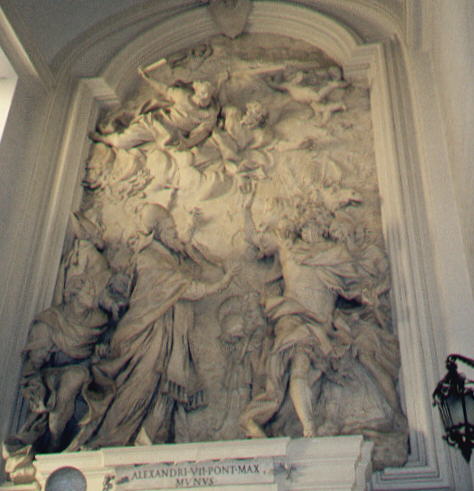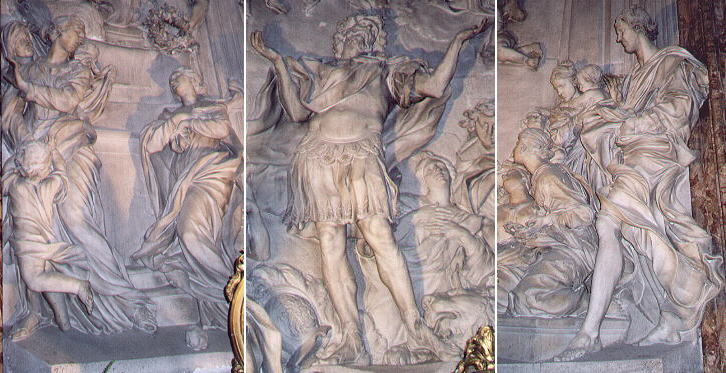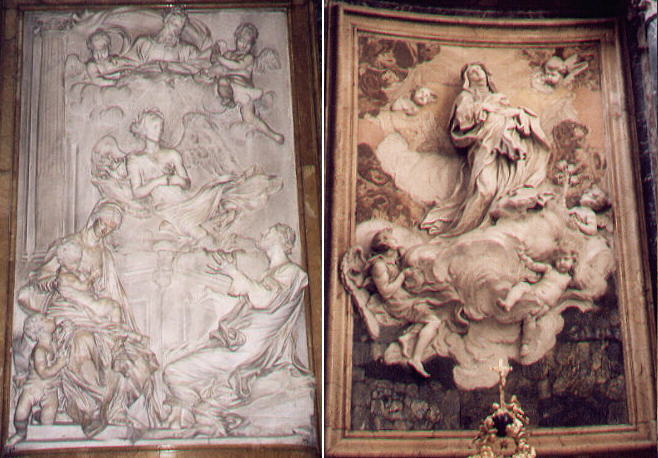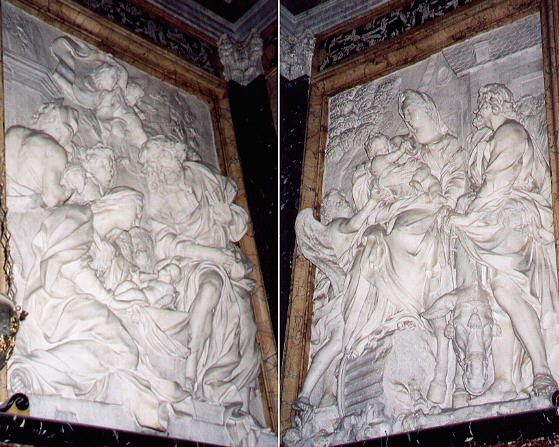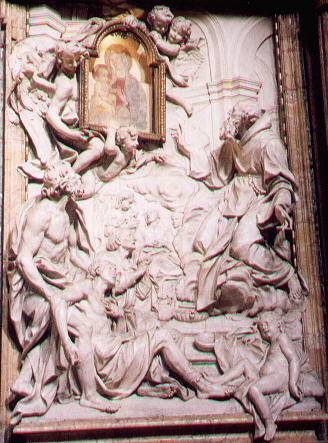

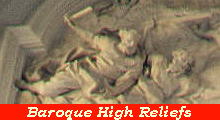 Baroque High Reliefs Baroque High Reliefs
The use of marble or bronze reliefs in the decoration of doors, monuments, fountains, fašades of palaces and churches was
widespread in XVIIth century Rome and it was based on both Classic (Trajan's Column) and Renaissance (Ghirlandaio, Donatello) models.
The fact however that Michelangelo, who was regarded as the supreme sculptor, had used reliefs only in some
early works, relegated this kind of sculpture to the level of a minor art. Gian Lorenzo Bernini shared this view and his reliefs
or reliefs designed by him and executed by others had an ancillary role in a more complex work of art (reliefs in Cappella Raimondi and Cappella Cornaro).
This general view was shaken by Alessandro Algardi in 1646 when he prepared a stucco model for a relief to be placed
on an altar in St Peter's. For that altar Guido Reni had been commissioned a painting
showing Pope Leo I repulsing Attila, King of the Huns. Guido Reni was commissioned other paintings and did
not go ahead with this commission. Cavalier d'Arpino, who got the commission after Guido Reni, died having only designed some initial sketches.
In 1646 Pope Innocentius X assigned the commission to Algardi whose work was immediately highly praised and considered a new kind
of work of art: the "marble painting".
Oratorio dei Filippini - Model for "St Leo repulsing Attila" by Alessandro Algardi (1646)
Algardi split the scene into three parts: the Pope and his cortege, Attila and the Huns and above them St Peter and St Paul descending fully armed from heaven. The Pope and Attila
are fully three-dimensional statues, while the other characters have more or less relief to give a sense of depth.
Algardi and Borromini were highly praised by Pope Innocentius X and they both were involved in the design of
S. Agnese in Agone.
S. Agnese in Agone - Details of the reliefs by (left) Ercole Ferrata - Martyrdom of S. Emerenziana (1660); (middle) Melchiorre CaffÓ - Martyrdom of S. Eustachio (1667); (right) Antonio Raggi - Martyrdom of S. Cecilia (1666)
Borromini asked Algardi to take care of the marble altar-pieces of five chapels (including the main one).
Algardi died in 1654 and the altar-pieces were designed and executed by Domenico Guidi, a scholar of Algardi, and by other sculptors who
often worked also with Gian Lorenzo Bernini (Ferrata, CaffÓ, Raggi). The scenes of these reliefs have architectonical elements (steps, columns) which help in indicating the
different scale of the figures. The influence of Bernini is particularly visible in the slender bodies and in the animated drapery. The relief by Melchiorre CaffÓ was clearly inspired by the
gigantic statue of S. Longino by Bernini.
S. Andrea della Valle - Vision of S. Giuseppe by Antonio Raggi (1675) and S. Caterina a Magnanapoli - Glory of S. Caterina by Melchiorre CaffÓ (1666)
For nearly a hundred years the richest chapels had marble altar-pieces. Antonio Raggi maintained Algardi's tripartition of the scene in his altar-piece in S. Andrea della Valle.
Melchiorre CaffÓ made an attempt to combine Algardi with Bernini in designing an altar-piece in S. Caterina a Magnanapoli.
The use of different marbles, the heads of cherubins, the
clouds are all references to works by Bernini.
S. Maria della Vittoria - The Sheperds and the Flight to Egypt by Pierre Monnot (1696)
Towards the end of the XVIIth century a more sober design began to prevail. This was in part due to the influence of French sculptors who after having studied in the
Accademia di Francia elected to live and work in Rome.
They can be considered Roman Baroque sculptors with a leaning for Algardi rather than Bernini. The reliefs by Pierre Monnot in Cappella di S. Giuseppe (a chapel opposite to Bernini's Cappella Cornaro) in S. Maria della Vittoria are a homage to Algardi.
S. Carlo al Corso - S. Francesco di Paola intercedes with Madonna dei Miracoli by Pierre Le Gros (1714)
Pierre Le Gros was the designer of a very creative altar-piece where a painting (a sacred image) was inserted into a high relief. It shows that the
interest in experimenting in new ways of combining architecture, painting and sculpture was alive in the first part of the XVIIIth century.
Marble altar-pieces continued to be fashionable until the end of the first half of the XVIIIth century.
Other marble altar-pieces in this web site:
Lorenzo Ottoni - Vision of the Holy Family in S. Maria in Campitelli
Francesco della Valle - Annunciation in S. Ignazio.

Other pages dealing with Baroque sculpture:
Statues in the act of praying
Representation of Death in Baroque sculptures
Monuments showing the dead in a medallion
Three chapels by Gian Lorenzo Bernini
Baroque Monuments to the Popes
Three busts by Alessandro Algardi
Baroque Angels
Statues Close to Heaven
Embittered Andrew (the statues in St. Peter's octagon)
Laughing Masks
Playing with Colours
See also my List of Baroque Architects and my Directory of Baroque Sculpture.
Go to my Home
Page on Baroque Rome or to my Home Page on Rome
in the footsteps of an XVIIIth century traveller.
|


 Baroque High Reliefs
Baroque High Reliefs
